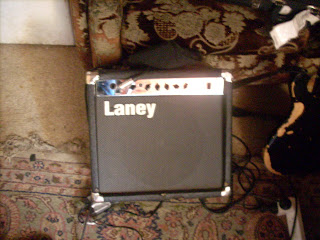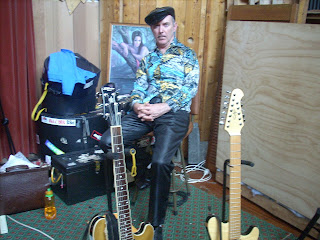This article appears in the May edition of the Melbourne Review. Demands of space led to cuts and edits. Also the subject material could have wandered occasionally into areas of specificity that casual readers might have been offended by. This is the full whack....
I wanted a sound for my electric guitar but was a little
cheesed at how everybody talks about the same shit in that area. I have
attitudes that have been formed over the years that affected my approach.
Basically I’m a singer. For the first couple of decades as a
performer I liked to stand there at the mic and sing. I didn’t want to be
stuffing around with a guitar. In the Moodists, Steve Miller had a Fender twin
and Mick Turner had a small Marshall combo. They were pretty intuitive as to
what they played. Somehow we arranged our one chord boogies by ear.
I should also say the Moodists were operating in the post
punk scene. Guitar heroes were few . These were ours. Johnny Thunders, Steve
Jones, Keith Levene, Tom Verlaine, Robert Quine, Lou Reed, Poison Ivy, Bryan
Gregory, Kid Congo, Rowland Howard.
Later, after the Moodists, I wanted to be a singer
songwriter in a 70s kind of way as that was the music I was tuning into. That’s what I’ve done ever since. I wrote songs on an acoustic guitar but
usually turned them over to my band, which pretty much always had a piano,
bass, guitar and drums. The guitar was always pretty trebly and clean and
played with the piano. Rod Hayward and Malcolm Ross in the Coral Snakes on
guitars (always Fenders) and Louis Vause and Robin Casinader on keys. The
guitar didn’t have to be the central part of the sound. We always had the
vocals and the rhythm section front and square. Influences from r&b I
guess. I had an acoustic guitar I bought from Robert Forster from the Go
betweens. A Fender acoustic. Twenty pounds it cost me. Some time in the late
80s I started to do some acoustic shows. The beginning of the vogue for all
things “unplugged” I guess. I bought some crappy Ovation style copy from Dean
street in London. Scratched out some performances that way. It was just a cheap way to get around.
Some time in the late 90s, after the Coral Snakes period, I
started to play electric guitar. Got myself a Harmony semi acoustic . I should say that during this period we had
started to use a lot of harmony singing and of course the sound on stage had to
be controlled a lot. The volume of the guitar is always an issue with lots of
open mics around. So we were always wanting the guitar amp to be at a lower volume.
I had started to think hard about textures and sound and
production and wanted to get a small combo with no piano and clean sounding
guitars. A beat group. Stuart Perera played guitar, a left handed solid body Rickenbacker. He put it through a Laney
combo and still does. Billy Miller played guitar with us as well. A strat
through a Roland Jazz Chorus. I liked it
all pretty loose. I played a bit of guitar then one day I put it down and found
that Bill and Stuart did not know how any of my songs actually went! We had
been playing songs from that songbook for a couple of years! The band needed me
to play the chords!
So I have kept playing the guitar and have brought all these attitudes to the situation. Low
volume, loud lead vocal, harmonies etc.
I am also by nature a contrarian and a cheapskate. If I had
tens of thousands of dollars to throw about I would not buy a guitar and an
amp, I would buy a car or something. Fix
something in my house.
When I was a kid I loved those dudes like Hound dog Taylor
and they all had the cheapest gear. Punk
bands like the Buzzcocks proudly had Tesco (supermarket) guitars and the Subway
Sect played Fender Squires.
I also always tune out when people start to rave about “warm
valve sounds”. I know, from experience, that its all true but there are other sounds. I mean Neil Young and The Foo Fighters might
record on tape and the like but they are millionaires. End of story.
The Moodists did a reunion gig in 2005 and the young new
rock sound engineer was telling our guitarist, who had his own sound and was an
original gangster, to “dial some mids in”. I had to tell the young cat that the
ideal sound was not always Bon Jovi or Aerosmith, this was the sound we had.
Steve turned all the treble on his amp up and there it was, that spindly, loud,
reverbed out Fender twin sound. The kid put his earplugs in.
That was a reunion
gig. I’d been putting out my own albums for more than 20 years in between
Moodists shows. By now I had some other references for guitar sounds that I
loved. Jerry Garcia, Jorma Kaukonen, John Cippolina, Ike Turner, Gatemouth
Brown, Grant Green, Duane Allman, Ed King. Lots of people. American rock and
jazz I guess.
So that’s where my attitude towards the sound I was looking
for came in. I can’t wipe all that away from my sensibility. That’s how I ended
up buying $120 solid state Fender combo
amp from ebay. It was covered in disgusting grey felt stuff. I had it replaced
with Marshall tolex. (the hard black vinyl type material on those amps).
Marshall people are not fender people. I was fooling with the material already.
The amp had a beautiful clean sound
which is what I wanted. Only it was piercingly loud and trebley. The volume was
at “1” and it was overpowering.
I became obsessed with building my own sound and scoured the
online guitar forums on different subjects. Needless to say, guitar folk love
to talk. All very subjective and persuasive to say the least. Also, all
continually searching for their own sound or more properly, one somebody else
had perfected.
My experiments led me to reach for a Sansamp, which is a
pedal that came out in the 80s for studio and live use, which could approximate
the sound of many different amps. Unlike the modern amp modelling pedals it was
not a case of switching a button it was a pedal with many variations and combinations
you could muck about with. I’d had one for twelve years and hadn’t ever really
gotten to the end of it. I placed it into the effects loop of my amp. This was
different to plugging it into the front. I did this because I wanted to have the sansamp “Fender tone”
effecting an actual Fender amp. I then replaced the speaker with a tech21 (the
maker of Sansamps) speaker, more powerful than the amp itself. The logic being
the speaker would be clean sounding to the infinite. (The overdrive channel of
the amp being so metallic I was going to use an overdrive pedal). So I had a
Fender amp and cab with tech21 in the loop and at the end.
Now I had to find the right combination and sequence to put
my pedals . I was intending to play 12 sstring electric and had a “Janglebox”
for compression and sparkle. The guitar went into this, then into an MXR Microamp.
The Microamp gave it a bit more of a clean boost. If it was before the
Janglebox its subtle effect was compressed too much and it affected the
overdrive pedal which came after it. (The Janglebox and Microamp were to be
“on” all the time). I then had a
“tonerider American classic” overdrive pedal for a dirty sound. Lastly there
was another Tech21 pedal, an XXL overdrive. This was for total fuzzed
distortion.
Having sequenced the pedals I had to work out which way to
power them. The sansamp needed to be reliably “on”. When the batteries run out
it is sudden, don’t want that to happen at a
gig. So I thought I’d get some power to the pedals. This involved a bit of research and, eventually, three power
plugs as the Sansamp and the Janglebox both require the power lead to be
positively tipped. (one male and one female) All other pedals being usually
negative tipped.
While looking into this I ventured once more into the world
of online opinion and critiquing of the electric guitar experience. The
language was pretty amazing- occasionally. I came across the terms “sag” and
“”bloom”. Using a valve amp, there is
a kind of power compression when a note
is hit hard and the amp can’t respond straight away. Being valves, they behave
differently to solid state circuits. The power “sags” and then gathers and
“blooms”, becoming louder and more resonant. Sag and Bloom. Like a couple of Jewish entertainment lawyers. I was
reading this stuff and really almost getting it. Then I had to investigate
power further as the Janglebox was very noisy being plugged into mains power. I
learned that people preferred batteries in the studio for a better sound but
mains power at gigs where reliability had to be uppermost. The sound was better
with batteries. New batteries? Well with that question a new rabbit hole
appeared when a fellow opined that the “sweetest” sound he’d ever heard was
when he used batteries that were just about to run out. Carbon batteries too,
whatever they were. I left the building at this stage, happy with the sound I
had been able to chase down, ready to go and play and record. Guitar and combo
amp still pretty much weighing in the same. Leaving them to all their endless talk.
Post script- now I need an ABY pedal to drive two amps.












